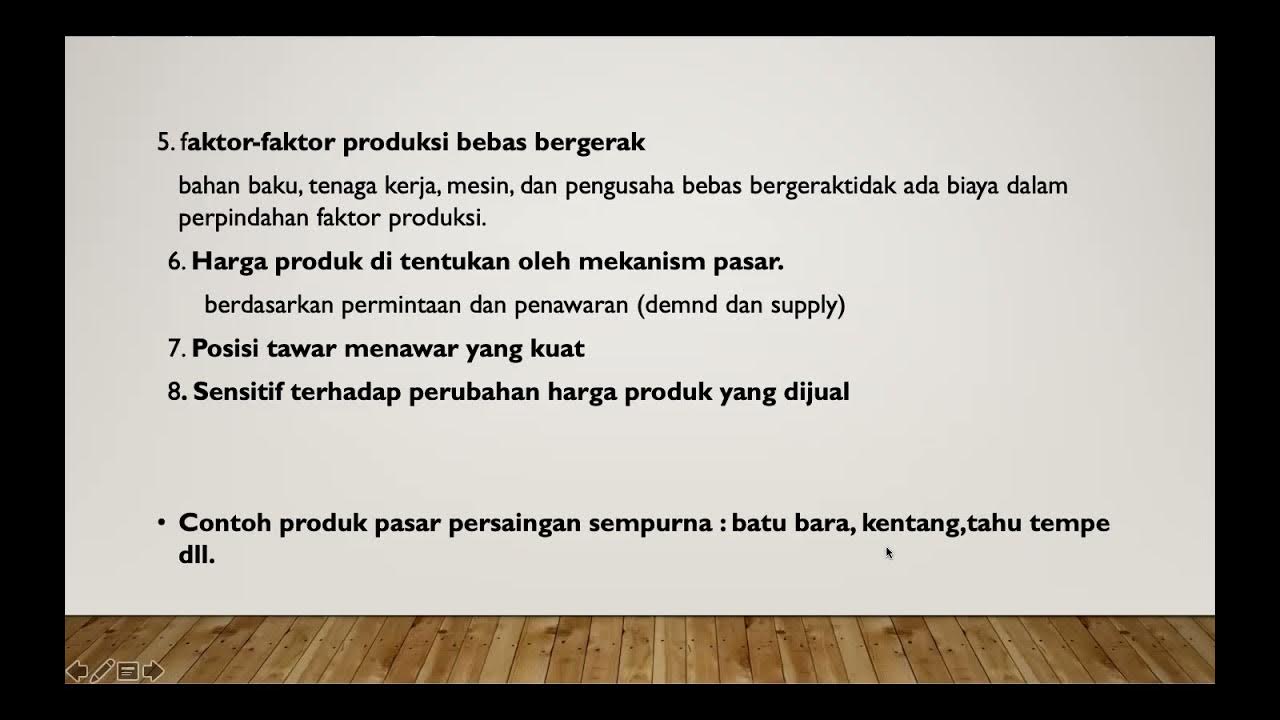Estruturas de Mercado: Concorrência Perfeita, Monopólio e Oligopólio
Summary
TLDRThe video explores different market structures, including perfect competition, monopoly, monopolistic competition, and oligopoly. It defines each structure, highlighting key characteristics such as the number of sellers, product differentiation, and market control. Perfect competition features many sellers with identical products, while a monopoly has a single seller dominating the market. Monopolistic competition allows for differentiated products among many firms, and oligopoly is characterized by a few large firms influencing market prices. Understanding these structures is essential for analyzing economic interactions and pricing strategies in various industries.
Takeaways
- 📈 The interaction between consumers and producers in a market determines the prices of goods and services.
- 🔍 Market structure refers to the organizational characteristics of a market that influence relationships between sellers and buyers.
- ⚖️ In perfect competition, many buyers and sellers exist, leading to a situation where no single participant can influence market prices.
- 🌾 Agricultural markets often approximate perfect competition due to numerous small producers and consumers.
- 🏢 A monopoly occurs when a single company is the sole provider of a good or service, establishing prices without competition.
- 🔒 Monopolies can arise from barriers such as exclusive control of resources, legal protections, or economies of scale.
- 🏷️ Monopolistic competition features many sellers with differentiated products, allowing some price control for individual firms.
- 🔗 Oligopoly is characterized by a few large firms dominating the market, where each firm's decisions impact the others.
- 📊 Barriers to entry in oligopolies can include high startup costs and established brand loyalty.
- 🌐 Understanding these market structures is essential for analyzing economic behavior and market dynamics.
Q & A
What is meant by 'market structure'?
-Market structure refers to the organizational characteristics of a market, which influence the relationships between sellers and buyers, as well as the behavior of firms in terms of pricing, output, and competition.
What are the key factors that define market structures?
-Key factors include the number of firms in the market, production capacity, consumer types, product differentiation, access to production technology, marketing strategies, and the availability of market information.
What characterizes perfect competition?
-Perfect competition is characterized by many buyers and sellers, homogeneous products, and the inability of any single buyer or seller to influence market prices. It also includes freedom of entry and exit in the market.
Can you provide an example of a market that resembles perfect competition?
-An example of a market resembling perfect competition is the agricultural market, where numerous small producers sell similar products to a large consumer base.
What is a monopoly, and how does it differ from perfect competition?
-A monopoly is a market structure where a single firm is the only supplier of a product or service, allowing it to set prices without competition. This contrasts with perfect competition, where multiple firms compete, and no single firm can influence prices.
What are some barriers to entry that can lead to a monopoly?
-Barriers to entry include exclusive control of essential resources, legal protections like patents, natural monopolies due to economies of scale, and established firms that dominate a market over time.
What defines monopolistic competition?
-Monopolistic competition is defined by many firms selling differentiated products, allowing for some degree of pricing power, unlike in perfect competition where products are identical.
How does oligopoly differ from other market structures?
-Oligopoly is characterized by a small number of large firms that dominate the market, where each firm's decisions affect others. This leads to interdependence among firms and potential for collusion to set prices.
What are some examples of oligopolistic markets?
-Examples of oligopolistic markets include the automotive industry, telecommunications, and major consumer goods sectors, where a few firms hold significant market share.
What is the role of product differentiation in monopolistic competition?
-Product differentiation in monopolistic competition allows firms to create a unique selling proposition through variations in design, quality, or branding, giving them some power to set prices above marginal cost.
Outlines

Esta sección está disponible solo para usuarios con suscripción. Por favor, mejora tu plan para acceder a esta parte.
Mejorar ahoraMindmap

Esta sección está disponible solo para usuarios con suscripción. Por favor, mejora tu plan para acceder a esta parte.
Mejorar ahoraKeywords

Esta sección está disponible solo para usuarios con suscripción. Por favor, mejora tu plan para acceder a esta parte.
Mejorar ahoraHighlights

Esta sección está disponible solo para usuarios con suscripción. Por favor, mejora tu plan para acceder a esta parte.
Mejorar ahoraTranscripts

Esta sección está disponible solo para usuarios con suscripción. Por favor, mejora tu plan para acceder a esta parte.
Mejorar ahoraVer Más Videos Relacionados

Ekonomi Mikro - Struktur Pasar Lainnya

Pasar Persaingan Sempurna, Pasar Monopoli, Pasar Oligopoli, Pasar Persaingan Monopolistik #pasar

PASAR: Struktur dan Bentuk-bentuknya

Game Theory and Oligopoly: Crash Course Economics #26

STRUKTUR PASAR

STRUKTUR PASAR (PASAR PERSAINGAN SEMPURNA, MONOPOLI, OLIGOPOLI, MONOPOLISTIK KELAS 10)
5.0 / 5 (0 votes)
